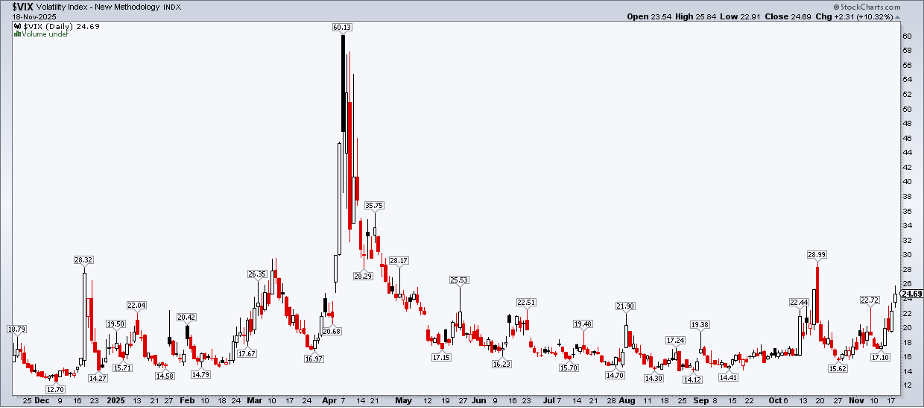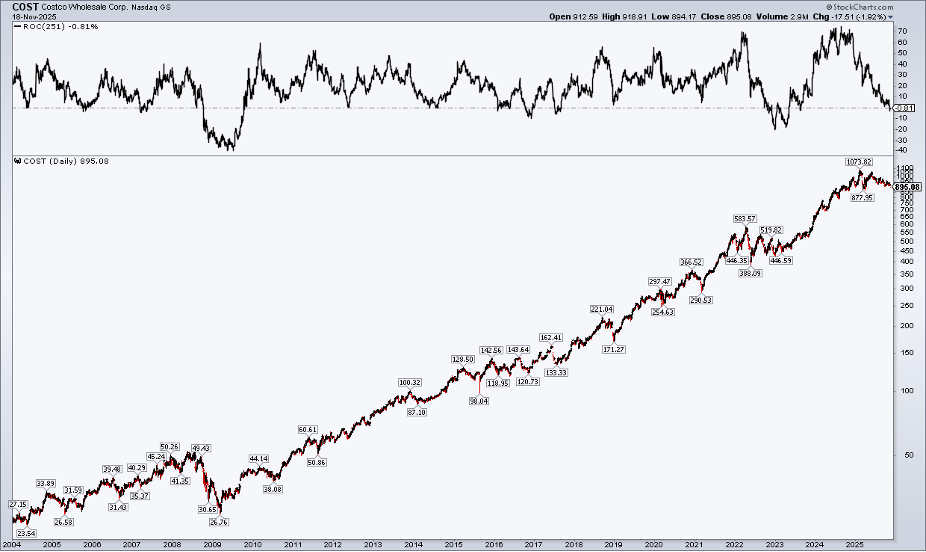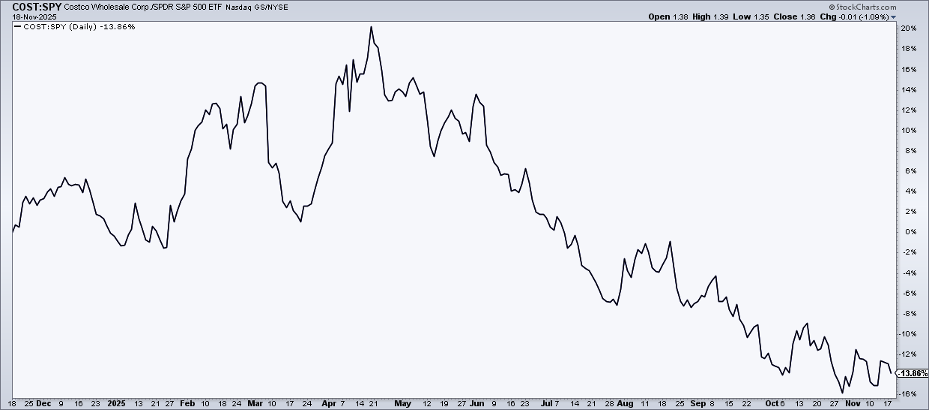Nvidia shares pop as analysts dismiss AI bubble concerns
Key Takeaways
- Volatility is unusually high heading into the holidays, suggesting a wild ride during what’s usually a period of quiet price action.
- Consumer stocks now lag the most — both Discretionary and Staples.
- Within the latter group, Costco has underperformed for months, and a key downside technical trigger is on the bears’ wish list.
Markets often ease into the end of the year. This part of the calendar often sports small daily moves, a withering VIX, and general optimism, as new sell-side forecasts paint rosy pictures of how financial markets will perform in the 12 months to come. Not this time, though; volatility is high, macro variables are many, and consumers are not happy.
VIX Not in the Usual Christmas Spirit
Look no further than Wall Street’s fear gauge. The VIX hovers in the mid-20s, the most ominous zone of them all. Schroders (and other research outlets) have published notes in recent years pointing out that forward S&P 500 returns are the worst when S&P 500 implied volatility is near 25.
I like to think of it as no man’s land — not low enough to support a year-end melt-up, but certainly not high enough to warrant a capitulation low and subsequent V-shaped snapback.
VIX inauspicious near 24.
What’s driving the unease? There are a few catalysts.
First, NVIDIA (NASDAQ:NVDA) earnings put mathematical upside to S&P 500 options pricing, as the stock is 8% of the index and shares are pricing in a 7% swing after it reports tonight. Second, macro traders are about to receive a data deluge, starting with Thursday’s dated September nonfarm payrolls report. In less than four weeks, we could be caught up with November economic indicators (although they may not be as robust as we’d all like, given the 40-day/40-night government shutdown).
Fed Up Yet?
Then, just earlier this week, President Trump announced he’d make his pick for the next Fed chief by December 31.
A more “politically correct” choice could be in the works, which markets may appreciate. Still, Kevin Hassett, a Trump loyalist, is the leading contender across prediction markets. Stocks and bonds would probably prefer Fed governor Chris Waller. Time will tell.
All the while, price action and performance trends voice their own story. There’s a dual message right now. Standing out most on my technical radar is the worsening weakness among consumer stocks.
I want to take you to StockCharts’ PerfChart of S&P sector ETFs. Bookmark this one, as you can tailor the timeframe and compare sector trends to the S&P 500 — ideal for absolute and relative strength analysis.

S&P 500 Sector ETF PerfChart. Consumer sectors are the worst YTD performers.
The Consumer Caboose
The macro tells us from the sector total returns? Household spending jitters. Yes, it’s a case in which price action confirms the downbeat UMich Sentiment Survey and the latest Consumer Confidence Index. Year to date, as pictured above, the Consumer Discretionary Select Sector SPDR ETF (NYSE:XLY) and the Consumer Staples Select Sector SPDR ETF (NYSE:XLP) bring up the rear among all 11 S&P 500 sector funds.
Dividends included, the two are essentially unchanged so far in 2025. We’ll know more once this week is out, with Walmart (NYSE:WMT), Target (NYSE:TGT), TJX Companies (NYSE:TJX), among others, posting Q3 numbers.
’Kirkland Signature’ Turns Messy
A major consumer name not reporting results this week could be the ultimate barometer: Costco (NASDAQ:COST). The $397 billion market-cap Consumer Staples Merchandise Retail industry company has long been a premium-P/E alpha generator, having little to do with AI or other secular tech growth narratives. Rather, it has commanded a sweet-spot presence among the middle–high-end U.S. spending cohort and boasts an annuity-like membership-fee revenue stream.
COST’s chart has nothing to be proud of right now, though. Shares have drifted down toward their April lows, just a few percentage points from a 52-week nadir. Zoom out and you’ll be hard-pressed to spot the last time COST notched a 12-month low.
Using the 251-day Rate of Change indicator, there have been just a handful of brief instances in which the stock was negative on a year-on-year basis. Those historical accolades are little help ahead of the holidays.
Costco

Costco Shares Drifting Lower. The Rate of Change indicator reveals rare instances of negative YoY returns.
COST:SPY. Selling in bulk
Warehouse Woes: Downside Potential
Shares are now 17% below their 52-week high, close to the worst drawdown since early 2023. Technically, a key support zone is in play. Notice in the chart below that the $873 to $903 zone is critical.
What’s more, a bearish death cross (in which the 50-day moving average drifts below the long-term 200-day moving average) occurred three months ago, while the RSI momentum oscillator at the top of the chart has printed a series of lower highs while not tagging technical oversold conditions. This is a market general that — if a correction continues to unfold — might be in the bears’ crosshairs.
A breakdown under $870 would trigger a downside measured-move price objective to about $660, based on the $200 range since the middle of 2024. And with a significant amount of volume-by-price now above today’s level, the bulls will have to stuff their giant carts full of shares sufficiently to bring COST through overhead supply.

Costco: $872-$903 Support, Death Cross, and 200dma Rolling Over.
Relating it to the Macro
Taking signal from price action, a breakdown would underscore a broadening of consumer weakness from the lower end to the higher end. Regardless of how the AI megatrend plays out, if the wealthier consumer breaks, that high VIX could go even higher.
The Bottom Line
Walmart and other big-box retailers are in focus this week, along with NVIDIA and happenings at the Fed. A volatility catalyst lies on the afternoon of December 11, when Costco reports its fiscal Q1 numbers (a day after the Fed decision). The stock has been a relative loser since April — yet another grinchy consumer clue.
Disclaimer: This blog is for educational purposes only and should not be construed as financial advice. The ideas and strategies should never be used without first assessing your own personal and financial situation, or without consulting a financial professional.
